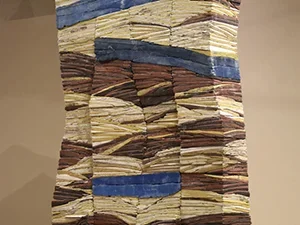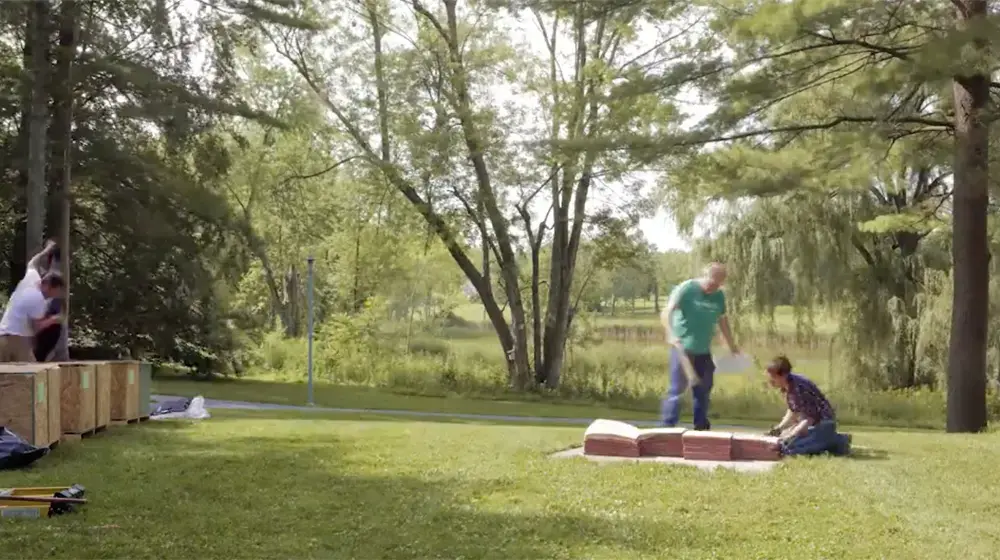Three Bridges, Eight Hundred Steps
Lydia Musco ’01 installed a concrete outdoor sculpture on August 16 and 17 on the lawn between VAPA and the back of the Barn. Incoming director of Usdan Gallery, Anne Thompson, asked her about the piece in the following Q & A.

Describe something that happened to you at Bennington that impacts your work as an artist today.
During my first year at Bennington, while I was working on a project in the print shop, I looked through the windows into the sculpture studios, where the sculpture class was working on a two-story-tall collaborative inflatable sculpture. I knew immediately that I needed to do that too. I’d been making objects since I was a kid, and was able to work in my dad’s woodshop as I got older, but it wasn’t until taking my first sculpture class at Bennington that I realized I could incorporate everything I loved about printmaking— line, color, layering, physicality of material—into three-dimensional objects that possess form, gravity, and balance. I use those lessons every day in my studio.
What was the inspiration of Three Bridges and how does it fit into the overall scope of your practice?
This piece was first built for an outdoor space near my hometown in rural Massachusetts. The color was intended to interact with the environment and the variations in color of the changing New England seasons. The piece is part of a body of work that deals with paired or grouped figures leaning on and/or supporting each other, forming a single wall, or a single shape, and also functioning as connected individuals. As the title suggests, the piece represents some kind of journey—not necessarily only a geographical journey, but also an analogy to ways in which we learn or grow. As with other pieces within this body of work, each figure is built from the ground up, the next figure is built against the first, and so on. I think of these pieces as accumulations of information—visual information of form, line, scale, texture, and color—and the directionality of the stacked layers relating to written languages, like building up letters to create words and putting together words to communicate stories and ideas.
Discuss the importance of scale in your work.
Scale is as much a part of my making vocabulary as form, material, color, and content. This body of work began with several rules I gave myself, one of which was that I could work only on a scale that I absolutely, truly understood. As it turned out, at the time that rule eliminated anything other than the scale of my own body, so that’s where I began. Since then, I’ve expanded the rule little by little as I began to understand more about scale. In nature and in the built environment, scale is based on a multitude of rules, so I try to find and apply similar rules for every object I build. In Three Bridges, for example, each column within the piece is related to the width of my shoulders. This particular piece needed to work in an outdoor environment, so it also had to relate to distances, viewpoints, and other natural and architectural objects around it. These days the scale of what I make still relates to a figure in some way, but the ratios change based on ways that make sense for each object. My most recent scale-related breakthrough was gaining a better understanding of how and why to build hand-held-sized objects.
Stacking—obviously an essential idea in your work—could have multiple implications in terms of process and form. How might “stacking” also function as a metaphor?
One of the other rules I established for this work was that I had to be able to handle and move the entire piece myself if necessary. Stacking many small pieces into a larger form was a logistical solution for me but simultaneously brought in a way to represent the layers of stories and memories that make up my experience of moving through life. Every time I interact with the repetitive stacking of these pieces I am reconstructing not only the way in which they were built, but also the moments that are encoded in the actions that created each layer. I think about sedimentary layers found in geology and the way that large and small moments can be recorded, but can also be changed over time. Every time I stack or unstack a piece, I am a different person, I’ve moved through time, and the object represents both the past—when it was built—and the present moment of being rebuilt. With the action of building up the form again, I’m reminded to consider, notice, and be aware of how things have changed, both from my own perspective and in the bigger picture.
Your pieces appear in multiple context—interior and exterior, private and public. How do you see Three Bridges relating to its surroundings on the Bennington campus?
I am so thrilled to have this piece at Bennington, and not only because of the beautiful landscape of Vermont or because this piece was conceived to stand in a New England environment. I have a vivid memory of a spring day at Bennington when the forsythia near VAPA had just bloomed in their super-saturated yellow,5 and the sky was a cloudless, flat, piercing blue. That visual memory has stayed with me. There are hints of that color lesson in this sculpture, so in some way, it’s coming back to one of its origins. I’m also excited to have this piece within an environment of learning and discovery. Every time I build a sculpture it teaches me something and helps me figure out what the next step will be. I see this piece relating to the idea of being within a group of people learning side by side, trying to figure out how to be individuals, how to find a voice, all happening amidst the many steps we take every day.
